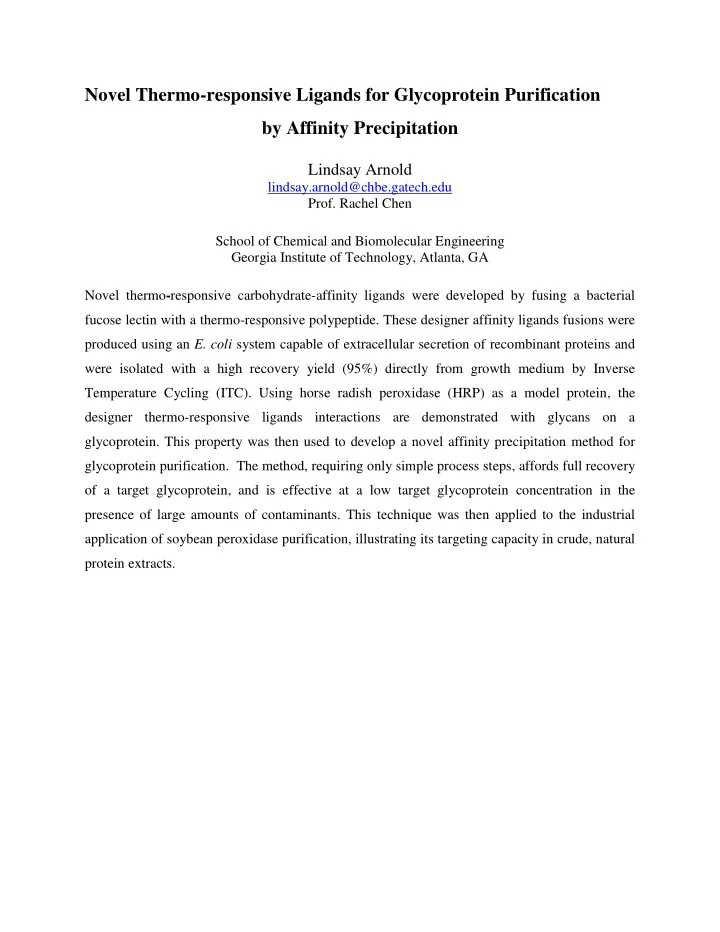

Novel Thermo-responsive Ligands for Glycoprotein Purification by Affinity Precipitation Lindsay Arnold lindsay.arnold@chbe.gatech.edu Prof. Rachel Chen School of Chemical and Biomolecular Engineering Georgia Institute of Technology, Atlanta, GA Novel thermo - responsive carbohydrate-affinity ligands were developed by fusing a bacterial fucose lectin with a thermo-responsive polypeptide. These designer affinity ligands fusions were produced using an E. coli system capable of extracellular secretion of recombinant proteins and were isolated with a high recovery yield (95%) directly from growth medium by Inverse Temperature Cycling (ITC). Using horse radish peroxidase (HRP) as a model protein, the designer thermo-responsive ligands interactions are demonstrated with glycans on a glycoprotein. This property was then used to develop a novel affinity precipitation method for glycoprotein purification. The method, requiring only simple process steps, affords full recovery of a target glycoprotein, and is effective at a low target glycoprotein concentration in the presence of large amounts of contaminants. This technique was then applied to the industrial application of soybean peroxidase purification, illustrating its targeting capacity in crude, natural protein extracts.
High-throughput Characterization of Morphological Phenotypes for Automatic Screening of C. elegans using Granulometry and Microfluidics Maria Elena Casas mecasas@chbe.gatech.edu Prof. Hang Lu School of Chemical and Biomolecular Engineering Georgia Institute of Technology, Atlanta, GA A major challenge in image processing is the characterization of densely packed overlapping objects. Segmentation algorithms have been used for object recognition; however, development of an appropriate algorithm for a high degree of occluded objects is difficult. To solve this issue, we present an algorithm for semi-quantitative textural analysis of biological samples using the principles of granulometry. We demonstrate the capability of this algorithm by conducting an automated high-throughput screen of lipid droplet size distribution phenotypes in C. elegans . Coupling the algorithm with microfluidics allowed for the identification of new lipid storage mutants at approximately 500 times faster than previously capable. Ultimately, this algorithm can be used for identification of lipid droplet phenotypes in other organisms, and determining genes that disrupt lipid storage in C. elegans can broaden future investigations that will impact the genetic understanding of metabolism and fat storage.
Ovarian Cancer Metastatic Tropism is Controlled by Matrix Rigidity Daniel McGrail danielmcgrail@gatech.edu Prof. Michelle Dawson School of Chemical and Biomolecular Engineering Georgia Institute of Technology, Atlanta, GA Though current treatments for localized ovarian cancer are highly effective, it still remains the most lethal gynecological malignancy, largely in part to late detection after tumor cells leave the primary tumor. Clinicians have long noted a clear predilection for ovarian cancer cells (OCCs) to metastasize to the soft omentum. Here, we show that this tropism is due not only to chemical signals but also mechanical cues. Metastatic OCCs preferentially adhere to soft microenvironments and display an enhanced malignant phenotype including increased migration, proliferation, and chemoresistance. To understand how cells sense substrate rigidity, we utilized traction force microscopy and found that OCCs on soft substrates increased both force magnitude and polarization. After culture on soft substrates, cells underwent morphological and molecular changes characteristic of epithelial-mesenchymal transition. Consistent with the idea that mechanical cues are a key determinant in the spread of ovarian cancer, mechanosensitivity was greatly decreased in less metastatic OCCs.
An Iterative Three-Stage Process for Generating Imidazolium Catalysts from Formaldehyde Ryan M. Clairmont ryan.clairmont@gatech.edu Prof. Andreas Bommarius, Prof. Charles Liotta School of Chemical and Biomolecular Engineering Georgia Institute of Technology, Atlanta, GA Iterative processes that use product feedback are important when engineering systems with the capacity to grow and adapt. In this work, a chemical process was developed to produce imidazolium ions that also act as catalysts for a process reaction step. The process can be sub - divided into three stages: two batch reactions (R1 & R2) and one chromatographic separation (S1). Stage R1 converts formaldehyde to a mixture of sugars (C n H 2n O n ) via an imidazolium catalyzed polarity reversal. Stage R2 takes the product mixture from R1 and adds aniline to produce new imidazolium catalyst in ___% overall yield. Side products generated in R2 decrease reaction efficiency and inhibit catalyst activity. Stage S1 purifies the imidazolium catalysts, allowing them to be recycled back into the process. By recycling product catalyst and increasing reagent concentration a factor of 1.5 each cycle, a 1300% increase in catalyst concentration was achieved over 5 iterations.
Recommend
More recommend